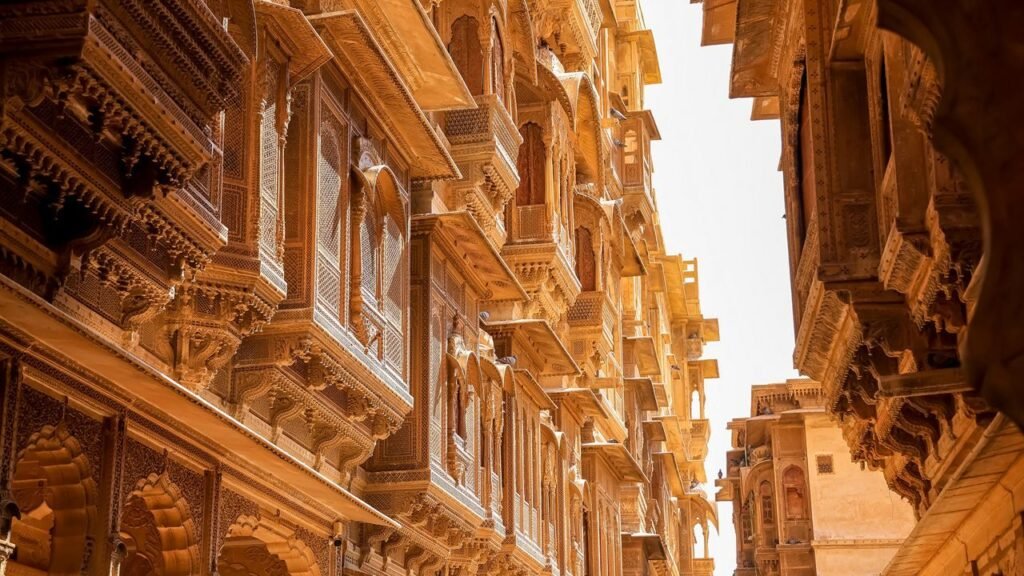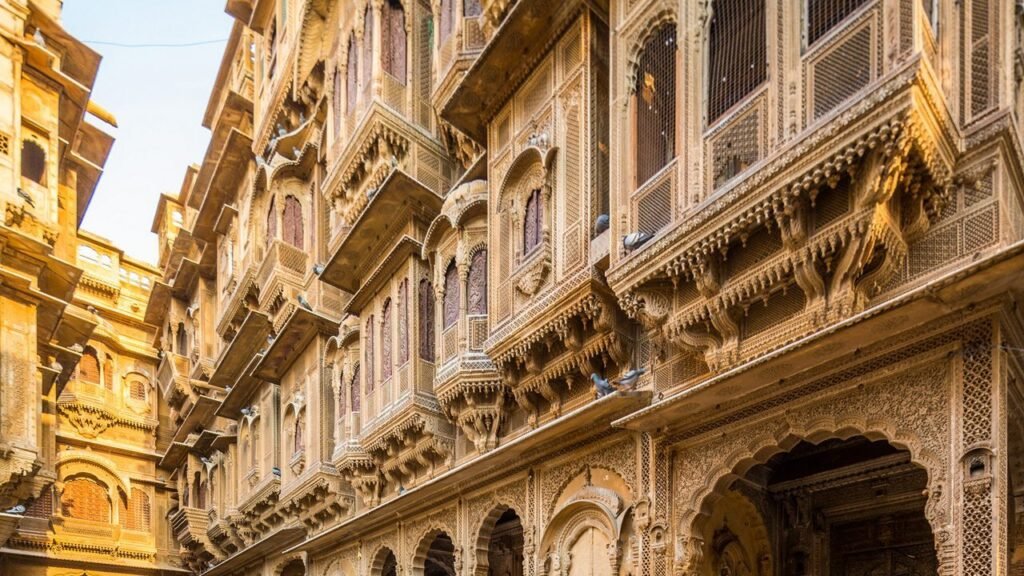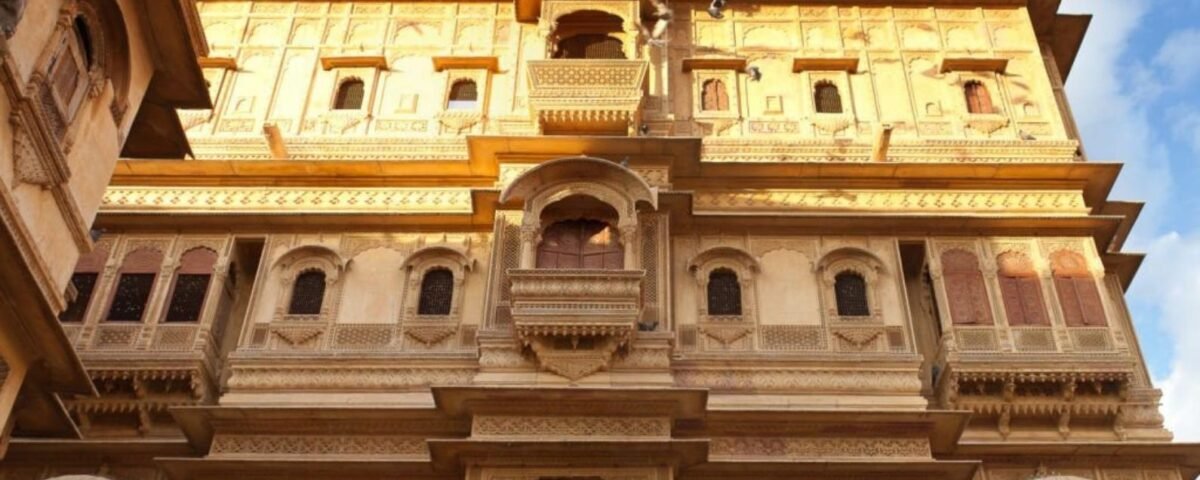- Luxury camp, Sam Sand Dunes, Jaisalmer, Kanoi, Rajasthan 345001
- +91- 7877954526
- tcarvaanresort@gmail.com

3-Day Jaisalmer Itinerary: Must-See Attractions
June 19, 2025
The Living Legacy of Jaisalmer Fort in the Thar Desert
July 16, 2025Nestled in the heart of the golden city of Rajasthan, Patwon Ki Haveli Jaisalmer stands as an awe-inspiring testament to the grandeur of Rajputana architecture, vibrant Marwari culture, and the opulent merchant lifestyle of the past. Often regarded as one of the finest and most elaborate havelis in Jaisalmer, it is not just an architectural marvel but a living relic of India’s golden era of trade, artistry, and design.
Introduction: The Jewel of the Golden City
Jaisalmer, often called the “Golden City”, is famed for its golden sandstone fort, sprawling deserts, and intricately carved havelis that dot the cityscape. Among them, Patwon Ki Haveli Jaisalmer shines brightest. Located just 500 meters from the Jaisalmer Fort, this haveli complex is often the first major attraction on every traveller’s itinerary—and for good reason. Its rich history, mesmerising architecture, and detailed craftsmanship make it one of the most visited and photographed places in the city.
Let us dive deep into the Patwon Ki Haveli history, its significance in Jaisalmer tourism, and why it’s considered the crown jewel among the havelis of Rajasthan.

Patwon Ki Haveli History: Legacy of a Wealthy Merchant
The Patwon Ki Haveli history dates back to the early 19th century when it was commissioned by Guman Chand Patwa, a wealthy trader and banker of the Jain community. This haveli was not built all at once but rather over a span of 60 years by the Patwa family. Interestingly, it’s not a single haveli but a complex of five distinct havelis, each built for the five sons of Guman Chand.
The Patwas were known for their extensive trade in brocade, gold, and silver threads (zari), and their wealth is evident in the ornate details of the haveli. This mansion complex served as a family residence and a hub of trade and administration.
A key aspect of Patwon Ki Haveli’s history is that it was the first haveli built in Jaisalmer, marking the beginning of the rich architectural tradition in the region. The intricate design of its facades, mirror work, murals, and jharokhas (balconies) speaks volumes about the refined taste and prosperity of its builders.
Architecture and Design: A Marwari Masterpiece
From the outside, Patwon Ki Haveli Jaisalmer looks like a golden mirage. Made entirely from yellow sandstone, it blends seamlessly with the city’s overall golden aesthetic. However, the real magic lies in its architecture—a fusion of Rajput and Mughal styles, enriched by Rajasthani aesthetics.
Key architectural features include:
- Exquisite Jharokhas: These intricately carved balconies are perhaps the most striking aspect of the haveli.
- Arched gateways and courtyards: The entrance arches are finely sculpted with floral and geometric motifs.
- Ceilings and Walls: Decorated with mirror work, miniature paintings, and floral carvings.
- Woodwork and Lattices: The use of intricate jali (latticework) windows offers both aesthetic beauty and practical ventilation.
Each of the five havelis within the Patwon Ki Haveli complex has its own personality. While the first one is the most grand and is maintained by the Archaeological Survey of India as a museum, the others are either residential or converted into shops and galleries. This variety makes exploring the haveli complex feel like stepping into different stories from the same book.
Inside the Haveli: A Museum of Living Culture
Walking into Patwon Ki Haveli Jaisalmer, you’re not just entering a heritage building—you’re stepping back in time. The museum maintained in the first haveli features:
- Old artefacts and furniture
- Costumes and textiles
- Wall paintings and frescoes
- Documents from the British era
- Miniature artworks and musical instruments
These exhibits provide a window into the lifestyle of Jaisalmer’s wealthy merchant families during the 18th and 19th centuries. You can also see how trade routes and desert caravans influenced the life and decor of the region.
Patwon Ki Haveli Jaisalmer: A Photographer’s Paradise
For photographers and Instagram enthusiasts, Patwon Ki Haveli Jaisalmer offers an absolute visual treat. Whether it’s the golden glow of the sandstone against the blue sky, the play of light and shadow through the lattice windows, or the intricate frescoes and mirror work, every frame is postcard perfect.
Professional shoots, pre-wedding photoshoots, and travel bloggers frequently feature Patwon Ki Haveli in their portfolios. It captures the romanticism of Rajasthan while preserving its historic authenticity.

Why Patwon Ki Haveli Is a Highlight of Jaisalmer Tourism
There are several reasons why Patwon Ki Haveli Jaisalmer is an unmissable stop for anyone visiting Rajasthan:
- Historical Significance: As the oldest haveli in Jaisalmer, it serves as a time capsule of the city’s golden age.
- Architectural Marvel: The sheer craftsmanship and preservation make it a standout structure.
- Cultural Insight: Offers a rare glimpse into merchant life, unlike palaces or forts dominated by royalty.
- Easy Accessibility: Located in the heart of the city, it’s within walking distance from other key attractions.
- Rich Exhibitions: The in-house museum is informative and well-curated.
Many tourists agree that Patwon Ki Haveli Jaisalmer gives a more intimate, human perspective on Rajasthan’s history compared to grand forts and palaces. You don’t just admire walls—you hear stories, feel textures, and connect with real people from the past.
Visitor Information: Timings, Tickets & Tips
If you’re planning to visit Patwon Ki Haveli Jaisalmer, here are some essential tips:
- Timings: Open from 9:00 AM to 5:00 PM daily
- Entry Fee: Nominal fee for Indians and foreigners; camera charges may apply.
- Best Time to Visit: October to March, when the weather is pleasant
- Nearby Attractions: Jaisalmer Fort, Nathmal Ki Haveli, Salim Singh Ki Haveli, and the bustling local bazaar
Travel Tip: Hire a local guide to fully understand the significance of carvings, symbols, and rooms. Many stories and meanings are hidden in plain sight.
How Patwon Ki Haveli Elevates Jaisalmer on the Global Tourism Map
Thanks to its well-preserved structure, cultural relevance, and accessible location, Patwon Ki Haveli Jaisalmer plays a crucial role in attracting global tourism to Jaisalmer. It features prominently in heritage tours, travel documentaries, and even international travel journals as a “must-visit” spot.
Moreover, heritage conservationists and architectural students from across the globe visit the site to study sandstone construction, desert architecture, and pre-modern ventilation techniques.
By visiting Patwon Ki Haveli, tourists also contribute to the preservation of Rajasthan’s tangible and intangible heritage, as parts of the revenue go toward restoration and community support.
Conclusion: A Living Chronicle of Marwari Grandeur
To sum it up, Patwon Ki Haveli Jaisalmer is far more than an architectural marvel—it is a narrative carved in stone. It tells the story of merchant dynasties, trade prosperity, and an aesthetic tradition that still commands awe. The Patwon Ki Haveli history reflects the pride of a community, the innovation of its artisans, and the enduring charm of Rajasthan’s cultural landscape.
So, whether you’re a history buff, an art lover, a cultural explorer, or a casual traveller, a visit to Patwon Ki Haveli Jaisalmer is bound to leave you enriched and enchanted. And to make your trip truly unforgettable, pair your cultural journey with a stay at the Best Desert Camp in Jaisalmer, where golden dunes, starry nights, and Rajasthani hospitality come together for an authentic desert experience.


